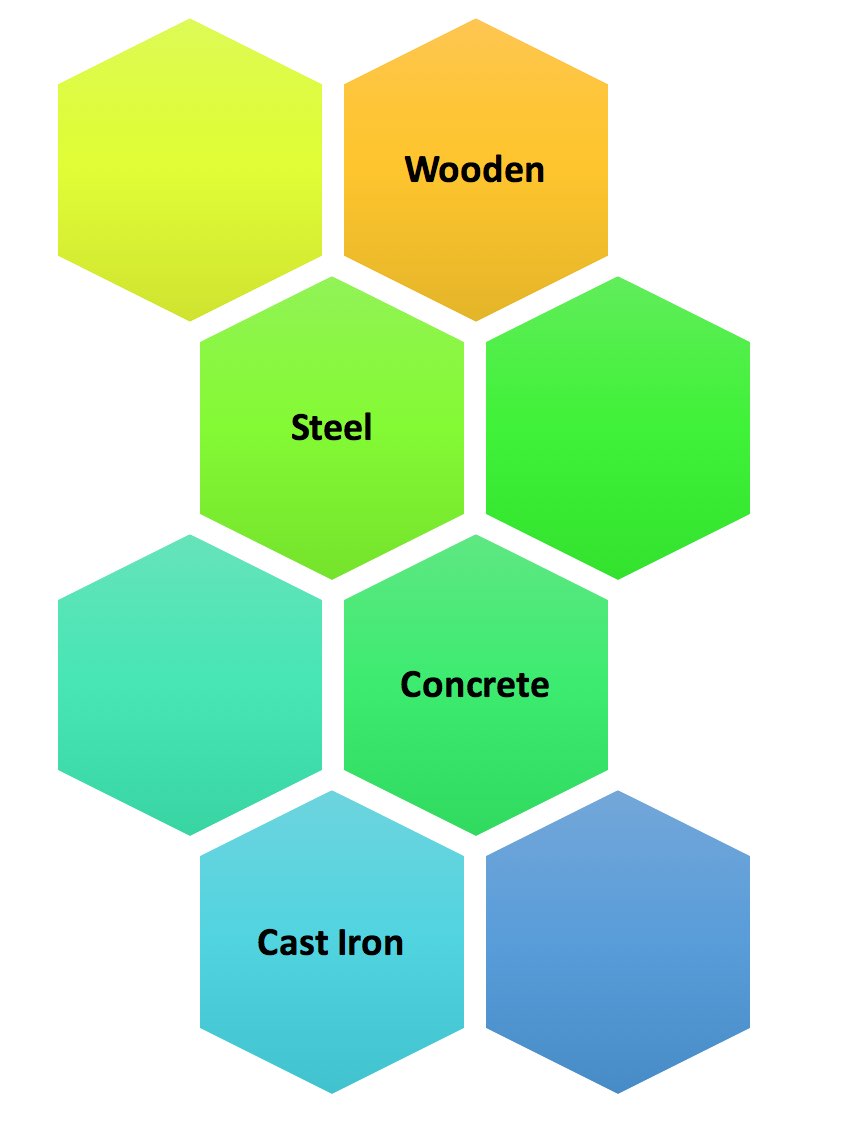Types of Railway Sleepers - Advantages & Disadvantages

Following are the types of railway sleepers:
1. Wooden Sleepers
These are commonly 254mm wide by 127mm thick in cross section by 2600 mm long. The sleepers are first seasoned (drying for up to 12 months so that to remove the juice/sap) and treated with preservative. Creosote is an oil generally used/ sprayed on the surface. They are either hard wood or soft wood type.
Wooden sleepers are the ideal type of sleeper. Hence they are universally used. The utility of timber sleepers has not diminished due to the passage of time.
Switch Ties: The primary use for switch ties is to transfer load (as from the name) and are made of hard wood. This type is preferably used in bridge approaches, heavily traveled, railway crossovers and as transition ties.
Softwood Ties: softwood timber is more rot (decay) resistant than hardwood, but does not offered resistance to spike hole enlargement, gauge spreading, also are not as effective in transmitting the load to the ballast section as the hardwood tie. Softwood ties and hardwood ties should not be mixed on the main track. Softwood ties are typically used in open deck bridges.
Concrete Ties: Concrete ties are rapidly gaining acceptance for heavy haul mainline use as well as for curvature greater than 2 degree. They are made of RCC or pre-stressed concrete containing reinforcing steel wires.
An insulator plate is placed between rail and tie to isolate the tie electrically.
Advantages of Wooden Sleepers
- They are cheap and easy to manufacture
- They are easy to handle without damage
- They are more suitable for all types of ballast
- They absorb shocks and vibrations better than other types of sleepers.
- Ideal for track circuited sections
- Fittings are few and simple in design
- Good resilience
- Ease of handling
- Adaptability to non standard situation
- Electrical insulation
Disadvantages of Wooden Sleepers
- They are easily liable to attack by vermin and weather
- They are susceptible to fire
- It is difficult to maintain gauge in case of wooden sleepers
- Scrap value is negligible
- Their useful life is short about 12 to 15 years.
2. Steel Sleepers
- Steel ties are used where wood or concrete is not favorable, for example in tunnels with limited headway clearance
- They are also used in heavy curvature prone to gage widening.
- This type of steel ties can cause problem to signals control system
- Some problem of fatigue cracking have also experienced.
- Due to the increasing shortage of timber in the country and other economic factors have led to the use of steel and concrete sleepers on railways.
In the design of Steel sleeper, the following are considered:
- It should maintain perfect gauge
- Can fix the rail and there should be no movement longitudinally
- Should have sufficient effective area to transfer load from rail to ballast.
- The metal of sleepers should be strong enough to resist bending
- The design life should be 35 years
Advantages of Steel Sleepers
- It is more durable. Its life is about 35 years
- Lesser damage during handling and transport
- It is not susceptible to vermin attack
- It is not susceptible to fire
- Its scrap value is very good
Disadvantages of Steel Sleepers
- It is liable to corrosion.
- Not suitable for track circuiting
- It can be used only for rails for which it is manufactured
- Cracks at rail seats develop during the service.
- Fittings required are greater in number
3. Cast Iron Railway Sleepers
They are further divided into two categories:
- Cast iron pot type sleepers
- Cast iron plate type sleepers
Advantages of Cast Iron Sleepers
- Service life is very long
- Less liable to corrosion
- Form good track for light traffic up to 110 kmph as they form rigid track subjected to vibrations under moving loads without any damping
- Scrap value is high
Disadvantages of Cast Iron Sleepers
- Gauge maintenance is difficult as tie bars get bent up
- Not suitable for circuited track
- Need large number of fittings
- Suitable only for stone ballast
- Heavy traffic and high speeds (>110kmph) will cause loosening of keys and development of high creep
4. Concrete Railway Sleepers
They have design life of up to 40 years. They can easily be moulded into the required/design shape to withstand stresses induced by fast and heavy traffic.
The added weight helps the rail to resist the forces produced due to thermal expansion and which can buckle the track. The weight of concrete sleepers is about 2.5 to 3 time the wooden sleepers. Pre-tensioned concrete sleepers are usually preferred now days
Reinforced Concrete and prestressed concrete sleepers are now replacing other types of sleepers except in some special circumstances like bridges etc. where wooden sleepers are used. Concrete sleepers may be of two types:
- Mono Block Concrete Sleepers
- TWIN BLOCK Concrete sleepers
Advantages of Concrete Sleepers
- It is more durable having greater life (up to 50years)
- It is economical as compare to wood and steel.
- Easy to manufacture.
- It is not susceptible to vermin attack
- It is not susceptible to fire
- Good for track circuited areas
Disadvantages of Concrete Sleepers
- It is brittle and cracks without warning.
- It cannot be repaired, and required replacement.
- Fittings required are greater in number.
- No scrap value













